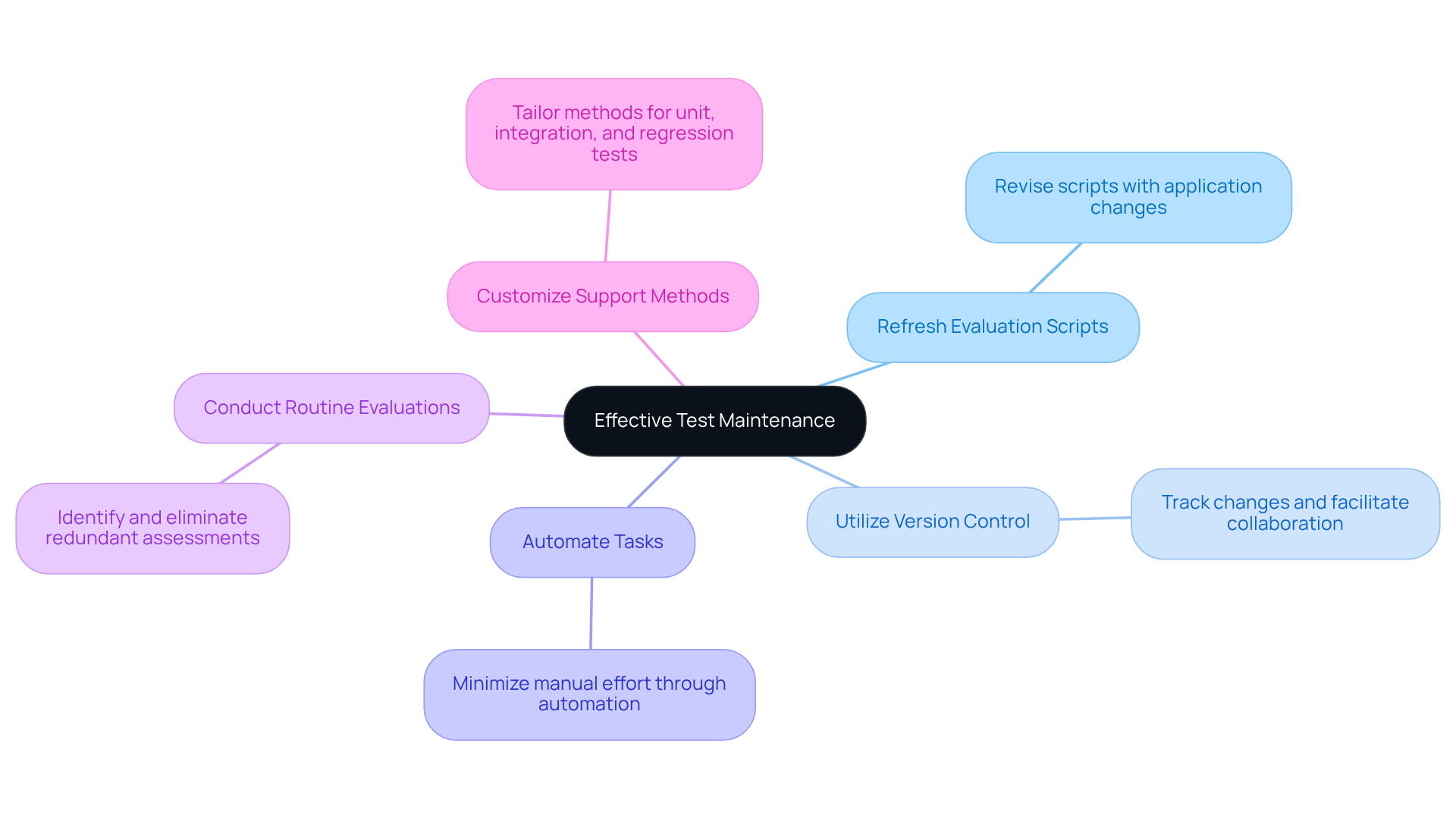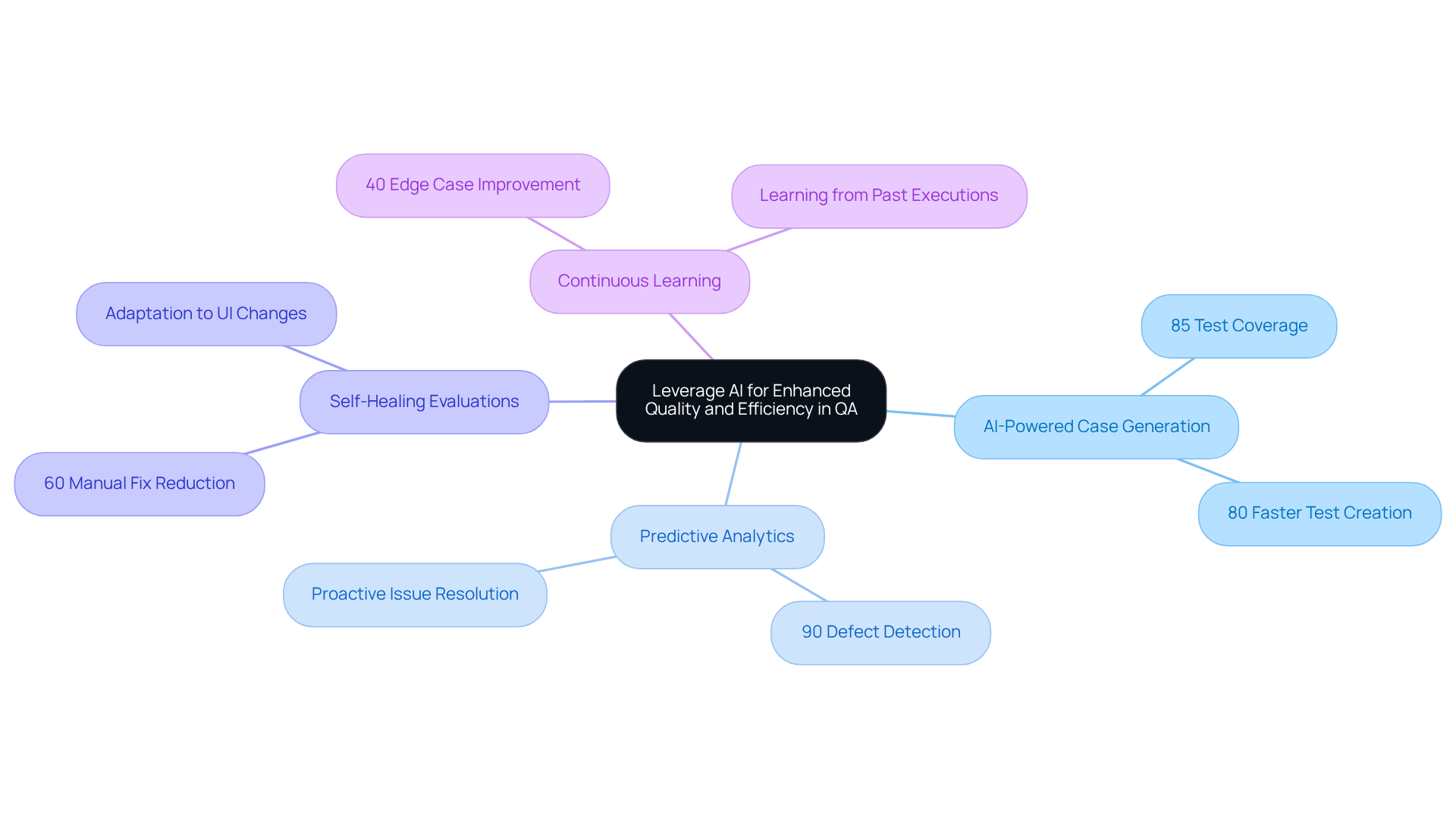Overview
The article highlights five strategies for effective AI test maintenance in quality assurance (QA), underscoring the significance of leveraging AI tools to enhance efficiency and quality in software testing. It presents best practices such as:
- Automating repetitive tasks
- Utilizing predictive analytics for proactive issue resolution
- Implementing self-healing evaluations
These strategies collectively contribute to improved test coverage and reduced manual effort, ultimately optimizing the overall QA process. Have you considered how these AI-driven approaches could transform your testing routines?
Introduction
The rapid advancement of artificial intelligence presents significant challenges for development teams, particularly in software testing. As coding complexities increase, how can teams effectively integrate AI into their testing processes? This integration is not merely a trend; it is a transformative approach that promises enhanced efficiency and accuracy in test maintenance. However, with these potential benefits come notable challenges. This article explores five strategic approaches that empower quality assurance teams to optimize AI test maintenance, ensuring they not only keep pace with evolving technologies but also elevate their testing practices to new heights.
Understand the Role of AI in Test Maintenance
In the ever-evolving landscape of software development, coding challenges are a constant hurdle for developers. AI plays a crucial role in AI test maintenance, effectively addressing these challenges. Tools like Kodezi automate repetitive tasks, enhance accuracy, and improve overall efficiency. By utilizing AI-driven functionalities, Kodezi simplifies processes, allowing quality assurance teams to focus on more strategic tasks.
Have you ever found yourself spending too much time on manual updates? Kodezi can automatically examine issues and resolve them, providing comprehensive explanations that help teams understand potential failures. This proactive approach not only reduces the time invested in manual updates but also ensures that evaluations remain relevant and efficient as the codebase evolves. Furthermore, the automated code debugging feature aids in creating new test cases based on modifications in the application, guaranteeing thorough coverage without the burden of manual involvement.
The benefits of using Kodezi are clear: improved productivity and enhanced code quality. By understanding AI's capabilities, especially through tools like Kodezi, teams can harness its full potential for AI test maintenance, leading to superior outcomes in evaluation. Explore the tools available on the Kodezi platform today and transform your coding practices.

Implement Best Practices for Effective Test Maintenance
Efficient AI test maintenance is crucial for software development teams dealing with coding challenges. To enhance their processes, groups should adopt several best practices.
- Consistently refreshing evaluation scripts is essential; ensure that these scripts are revised in accordance with application modifications to uphold their applicability.
- Utilizing version control for script revisions allows teams to track changes and facilitates collaboration among members.
- Automating where possible is highly beneficial. By utilizing AI test maintenance to automate repetitive tasks, such as case generation and execution, teams can minimize manual effort and enhance overall efficiency.
- Conducting routine evaluations is another key practice; scheduling regular assessments of the evaluation suite helps identify and eliminate redundant or outdated assessments, ensuring that the suite remains lean and effective.
- Customizing support methods for various types of evaluations—such as unit, integration, and regression—ensures thorough coverage and dependability.
By adhering to these best practices, groups can significantly enhance their maintenance procedures and improve overall software quality.

Leverage AI for Enhanced Quality and Efficiency in QA
To enhance quality and efficiency in QA, teams should consider adopting several strategies for AI test maintenance. AI-Powered Case Generation stands out as a pivotal approach. By utilizing AI tools, teams can automate AI test maintenance to produce a diverse array of scenarios based on application requirements and historical data. This not only boosts test coverage by up to 85% but also significantly reduces the time spent on manual test creation, with AI test maintenance contributing to 80% faster test creation.
Furthermore, Predictive Analytics plays a crucial role in modern QA processes. Implementing AI-driven predictive analytics in AI test maintenance allows teams to foresee potential failures, enabling proactive issue resolution. This method enhances AI test maintenance efficiency, enabling groups to concentrate on high-risk areas and improving defect detection rates by up to 90% compared to manual testing. Additionally, the automated code debugging system swiftly detects and addresses problems, ensuring that the most essential areas are prioritized.
In addition, Self-Healing Evaluations offer a significant advantage. By utilizing AI capabilities, assessments can automatically adapt to application changes, thereby reducing the need for AI test maintenance and ensuring ongoing evaluation effectiveness. Self-healing scripts can eliminate up to 60% of the usual manual fixes required after UI updates. The debugging function of the software further assists in this by ensuring that any underlying code problems are resolved quickly, enabling self-healing evaluations to operate at their best.
Moreover, teams should embrace Continuous Learning through AI test maintenance that learns from past test executions and outcomes. This continuous refinement process can lead to a 40% improvement in edge case coverage, ensuring that testing remains robust as applications evolve. By integrating these AI strategies into their QA processes, along with Kodezi's automated code debugging, teams can achieve higher quality software with greater efficiency, ultimately enhancing their competitive edge in the market.

Conclusion
Incorporating AI into test maintenance represents a transformative approach for software development teams, enabling them to tackle coding challenges with enhanced efficiency and effectiveness. How can teams streamline their processes? By utilizing AI-driven tools like Kodezi, teams can automate repetitive tasks, reduce manual updates, and ultimately focus on more strategic quality assurance activities. This shift not only streamlines processes but also significantly boosts overall productivity and code quality.
The article outlines several best practices crucial for effective AI test maintenance. Key strategies include:
- Consistently updating evaluation scripts
- Leveraging version control
- Automating repetitive tasks
- Conducting routine assessments
- Customizing support for different evaluation types
These practices collectively contribute to a more efficient maintenance process, ensuring that software quality remains uncompromised as applications evolve.
Embracing these AI strategies not only enhances the quality and efficiency of QA processes but also positions teams to stay competitive in a rapidly changing environment. By adopting AI-powered case generation, predictive analytics, self-healing evaluations, and continuous learning, organizations can achieve substantial improvements in defect detection and test coverage. The integration of AI into test maintenance is not just a technological upgrade; it is a critical step toward ensuring robust software quality and operational excellence. Explore the tools available on the Kodezi platform to elevate your development processes.
Frequently Asked Questions
What role does AI play in test maintenance?
AI plays a crucial role in test maintenance by automating repetitive tasks, enhancing accuracy, and improving overall efficiency in software development.
How does Kodezi assist with test maintenance?
Kodezi automates manual updates, examines issues, resolves them, and provides comprehensive explanations to help teams understand potential failures, thereby reducing the time spent on manual updates.
What advantages does Kodezi offer for quality assurance teams?
Kodezi allows quality assurance teams to focus on more strategic tasks by simplifying processes and ensuring evaluations remain relevant and efficient as the codebase evolves.
How does Kodezi contribute to code debugging?
Kodezi features automated code debugging that creates new test cases based on modifications in the application, ensuring thorough coverage without requiring manual involvement.
What are the benefits of using Kodezi for test maintenance?
The benefits of using Kodezi include improved productivity and enhanced code quality, allowing teams to leverage AI's capabilities for better evaluation outcomes.
Where can teams learn more about Kodezi and its tools?
Teams can explore the tools available on the Kodezi platform to transform their coding practices and enhance their test maintenance processes.




